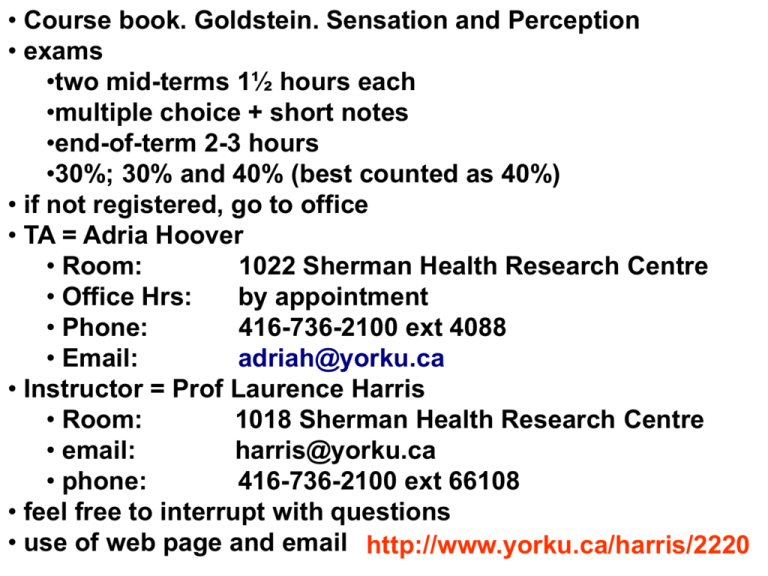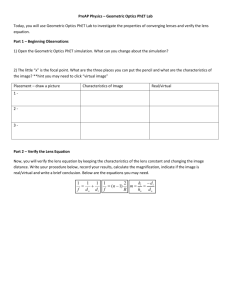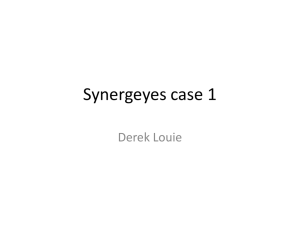lecture 1
advertisement

• Course book. Goldstein. Sensation and Perception • exams •two mid-terms 1½ hours each •multiple choice + short notes •end-of-term 2-3 hours •30%; 30% and 40% (best counted as 40%) • if not registered, go to office • TA = Adria Hoover • Room: 1022 Sherman Health Research Centre • Office Hrs: by appointment • Phone: 416-736-2100 ext 4088 • Email: adriah@yorku.ca • Instructor = Prof Laurence Harris • Room: 1018 Sherman Health Research Centre • email: harris@yorku.ca • phone: 416-736-2100 ext 66108 • feel free to interrupt with questions • use of web page and email http://www.yorku.ca/harris/2220 Timetable for 2220 1 2 3 4 5 6 7 8 9 10 11 12 (2011) Jan 4 Jan 11 Jan 18 Jan 25 Feb 1 Feb 8 Feb 15 Feb 22 March 1 March 8 March 15 March 22 March 29 <-- intro TBA <-- Final exam <-- midterm 1 reading week <-- midterm 2 PSYCH 2220 Perception http://www.yorku.ca/harris/2220 Introduction WHAT IS PERCEPTION? Awareness of world objects people self Depends on sensory IN but also memory FIELDS CALLED UPON IN THIS COURSE Natural History Art Biology Medicine Philosophy Physics Neuroscience Anatomy Biochemistry Painting by Modigliani Penguin MODULAR ORGANIZATION pattern place depth colour movement Photos by Edward Muybridge Theories about how these are put together DEVELOPMENT PSYCH 2220 Perception Lecture 1 ELECTROMAGNETIC RADIATION airwaves MECHANICAL (X-rays…) Ultra-violet visible light infra-red (radio waves..) some insects human vision pit viper Ultra-sound hearing range very-low freqs bats, dophins, rats human hearing whales, frogs From outside touch, pain pressure From inside In air From same species pheromones, smell From outside smell From inside taste CHEMICAL In mouth Lateral line of fishes vestibular organ proprioception Bee’s view of a flower – markings visible only because different parts of the petal reflect ultra-violet rays differently. THE PIT Pit Viper Moth Physical World Sense Organs Brain Perception Eye movements Point eyes to right place Accommodation focus Pupils Light Adaptation Adjust for the light level Transduction Convert light energy to activity in cells Focusing and accommodation ACCOMMODATION fine tuning of focus by the lens REMEMBER: most of the refraction occurs here at the CORNEA DISTANT OBJECT eg. star CLOSE OBJECT The eye and its optics 4 - 4 SHORT SIGHTED (Myopia) DISTANT OBJECT eg. star Even the relaxed lens is too strong. The rays are focused in front of the retina! DISTANT OBJECT eg. star The CONCAVE lens makes the rays DIVERGE, thus compensating for the unwanted strength of the eye's optics. The eye and its optics 4 - 5 LONG SIGHTED (Hyperopia) CLOSE OBJECT The fully-contracted lens cannot get strong enough. The rays are focused behind the retina! CLOSE OBJECT The CONVEX lens helps the rays CONVERGE, thus assisting the inadequate strength of the eye's optics. The eye and its optics 4 - 6 Most of the refraction takes place at the air/water boundary of the CORNEA in the air Lens in the eye of an AIR-LIVING animal AIR LIVING No refraction takes place at the water/water boundary of the CORNEA in the water Lens in the eye of a WATER-LIVING animal WATER LIVING DIVING ANIMALS 1 put on a mask that keeps air in front of cornea 2 rely on a STRONG lens that can change from air-living to water living eg: otter Air Type 3 Have a FLAT cornea (to remove its influence) and then use a WATER-LIVING style lens eg. Penguin, flying fish Water Type 4 Have two pairs of eyes - one for each environment eg. Four-eyed fish 5 Use a WATER-LIVING style lens in the water and bi-pass the cornea by using a PIN HOLE pupil on land eg. seal Penguin Flying fish Four-eyed fish Four-eyed fish Pupils and light adaptation Photo taken through a LARGE aperture shallow depth of field (only one distance is in focus) Photo taken through a SMALL aperture long depth of field (lots of distances are in focus) Structure of eye and retina







